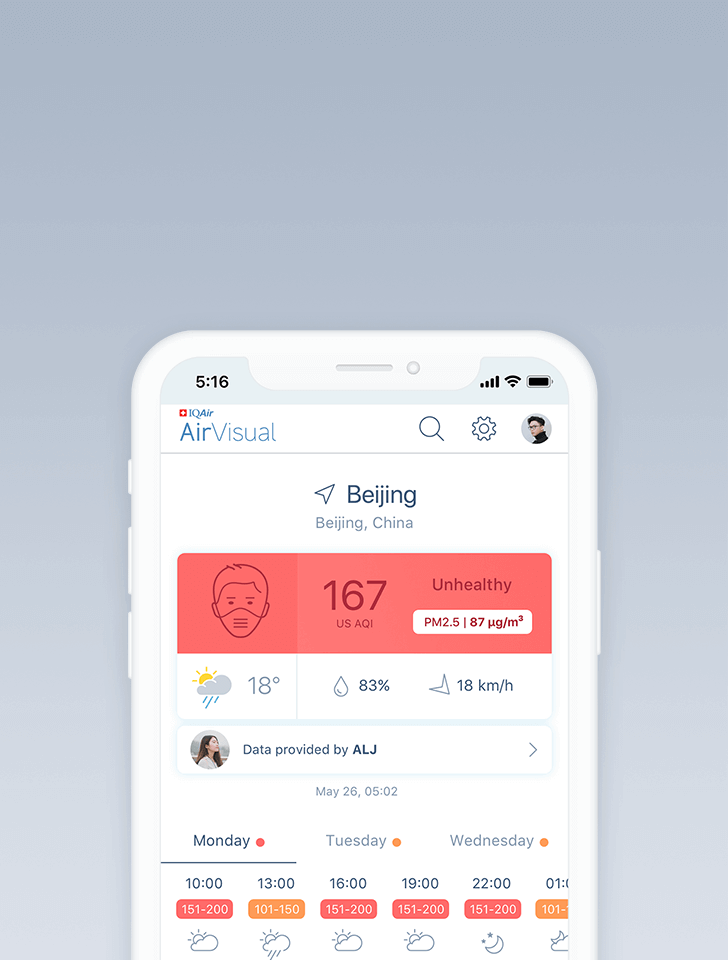Air quality in Chongqing
Air quality index (AQI) and PM2.5 air pollution in Chongqing
168.4K people follow this city

Chongqing Air Quality Map
Real-time Chongqing air pollution map
Weather
What is the current weather in Chongqing?
| Weather | Broken clouds |
| Temperature | 69.8°F |
| Humidity | 61% |
| Wind | 2.1 mp/h |
| Pressure | 29.7 Hg |
live aqi city ranking
Real-time China city ranking
| # | city | US AQI |
|---|---|---|
| 1 | Zhangye, Gansu | 280 |
| 2 | Leshan, Sichuan | 172 |
| 3 | Beijing, Beijing | 166 |
| 4 | Jinchang, Gansu | 162 |
| 5 | Jingmen, Hubei | 158 |
| 6 | Nagqu, Tibet | 158 |
| 7 | Wuhan, Hubei | 158 |
| 8 | Jinzhou, Liaoning | 157 |
| 9 | Shunyi, Beijing | 157 |
| 10 | Suizhou, Hubei | 157 |
(local time)
SEE WORLD AQI RANKING3D animated air pollution map

live Chongqing aqi ranking
Real-time Chongqing air quality ranking
| # | station | US AQI |
|---|---|---|
| 1 | Zhou Bai | 107 |
| 2 | Zhoubai | 93 |
| 3 | Huxi | 82 |
| 4 | Shangqing Temple | 80 |
| 5 | Longshan County | 68 |
| 6 | Xishan | 68 |
| 7 | Beibei | 65 |
| 8 | Cai Jia | 61 |
| 9 | Yanhe Tujia Autonomous County | 57 |
| 10 | Wuchuan Gelao and Miao Autonomous County | 50 |
(local time)
SEE WORLD AQI RANKINGUS AQI
63
live AQI index
Moderate
Overview
What is the current air quality in Chongqing?
| Air pollution level | Air quality index | Main pollutant |
|---|---|---|
| Moderate | 63 US AQI | PM2.5 |
| Pollutants | Concentration | |
|---|---|---|
| PM2.5 | 18µg/m³ | |
| PM10 | 28.5µg/m³ | |
| O3 | 26µg/m³ | |
| NO2 | 11.5µg/m³ | |
| SO2 | 5.5µg/m³ | |
| CO | 600µg/m³ | |
PM2.5
x3.6
PM2.5 concentration in Chongqing is currently 3.6 times the WHO annual air quality guideline value
Health Recommendations
What is the current air quality in Chongqing?
| Sensitive groups should reduce outdoor exercise | |
| Close your windows to avoid dirty outdoor air GET A MONITOR | |
| Sensitive groups should wear a mask outdoors GET A MASK | |
| Sensitive groups should run an air purifier GET AN AIR PURIFIER |
Forecast
Chongqing air quality index (AQI) forecast
| Day | Pollution level | Weather | Temperature | Wind |
|---|---|---|---|---|
| Tuesday, Apr 23 | Moderate 64 AQI US | 71.6° 51.8° | ||
| Wednesday, Apr 24 | Moderate 66 AQI US | 66.2° 57.2° | ||
| Thursday, Apr 25 | Moderate 65 AQI US | 62.6° 53.6° | ||
| Today | Moderate 63 AQI US | 73.4° 53.6° | ||
| Saturday, Apr 27 | Moderate 73 AQI US | 71.6° 59° | ||
| Sunday, Apr 28 | Moderate 89 AQI US | 77° 59° | ||
| Monday, Apr 29 | Moderate 76 AQI US | 66.2° 62.6° | ||
| Tuesday, Apr 30 | Moderate 58 AQI US | 60.8° 55.4° | ||
| Wednesday, May 1 | Moderate 56 AQI US | 59° 51.8° | ||
| Thursday, May 2 | Moderate 57 AQI US | 51.8° 48.2° |
Interested in hourly forecast? Get the app
AIR QUALITY ANALYSIS AND STATISTICS FOR Chongqing
What is the air quality index of Chongqing?
Chongqing is a megacity in southwest China. The population was estimated to be approximately 31 million in 2018. It is one of the four municipalities which fall under the direct control of the central Chinese government. The other three being Beijing, Shanghai and Tianjin.
At the end of 2020, the quality of air in Chongqing was “Unhealthy for Sensitive groups” with a US AQI reading of 103. These are based on the recommended figures as suggested by the World Health Organisation (WHO). The recorded levels of the pollutants that cased the poor air were as follows: - PM2.5 - 36.5 µg/m³, PM10 - 57 µg/m³, ozone (O3) - 14.5 µg/m³, nitrogen dioxide (NO2) - 40 µg/m³ and sulphur dioxide (SO2) - 8 µg/m³. With levels such as these, the advice for sensitive groups of people is to wear a mask when leaving the house. Closing doors and windows will help stop the ingress of dirty air into the home and consider running an air purifier if one is available. Outdoor exercise should be avoided by all until the air quality gets better.
In 2019, Chongqing recorded an average annual figure of 37.1 µg/m³, which falls into the “Unhealthy for sensitive groups” category. For 7 months of the year though the figure was “Moderate” with levels between 12.1 and 35.4 µg/m³. For February and November, it was “Unhealthy for sensitive groups” with figures between 35.5 and 55.4 µg/m³. December and January put it into the “Unhealthy” group with readings of 55.5 to 150.4 µg/m³. Looking back at previous years the air quality is getting slightly better. In 2017 it was 43.9 µg/m³ and in 2018 it was 37.3 µg/m³.
Why Chongqing is polluted?
Since the 80s, Chongqing has experienced rapid development in industrialisation. As these practices expanded, so too did the need for energy. This energy was supplied through the use of cheap coal bought in from northern China, but known to be of poor quality. This sharp increase in coal consumption led to a rise in the concentrations of sulphur dioxide (SO2) and consequently to the formation of acid rain. Following this period of growth, acid rain occurred at a 50 per cent higher frequency than previously had been experienced in rural areas of Chongqing. The pH was low at about a 4.5, (7 is the average figure). Due to this development, the population of Chongqing was more exposed to respiratory diseases, forest density declined, and buildings became corroded. In order to protect the local population and to improve air quality and protect the city infrastructure, the government and environmental agencies began to make desperate efforts to control industrial emissions.
This situation is exacerbated by the topography of the area. Recently only levels of the common air pollutants had been measured such as sulphur dioxide (SO2), oxides of nitrogen (NOx), smoke and suspended particulate matter PM 2.5 and PM10, with little attention paid to photochemical oxidants such as ozone (O3). Ozone is known to have a detrimental effect on plants and trees. Many crops locally grown in and around Chongqing were found to be affected by ozone.
Is air pollution in Chongqing getting worse?
In 2019, China published a work report stating its intentions to reduce levels of sulphur dioxide (SO2), nitrogen oxides (NOx) and the fine particulate matter of PM2.5 and PM10 by 3 per cent in key density areas. In 2018, the number of days that attained a good level air quality reached 316, with a year-on-year increase of 13 days. The annual mean density of PM2.5 decreased by 11.1 per cent on the year-on-year basis.
Chongqing will continue to focus on the “blue sky” ideal and rigorously control pollution from traffic, industry, dust, and daily living. It will also strengthen the regulations and research capabilities and fully implement the new European-style standards for vehicle exhaust emissions.
What can be done to improve the air quality in Chongqing?
Chongqing aims to guarantee that the number of days with good air quality is more than 300 and the annual average PM2.5 concentration falls below the 40 µg/m³ figure. It plans to strengthen air quality forecasting and give early warnings to the public in order that they can prepare themselves. It will also carry out regional joint prevention and control measures, as well as cross-regional law enforcement inspection and cross-checks.
Two of the major sources of sulphur dioxide recently were retrofitted with flue gas desulphurisation units. Measurements taken after they were used revealed levels had dropped by 95 per cent which equates to approximately 167,000 tons of sulphur dioxide annually.
All newly built users of coal as their main source are compelled to have desulphurisation facilities installed. Most coal used in Chongqing has a high sulphur content of around 3.5 per cent.
The Chinese government provided a substantial amount of money in order to assist smaller users to comply. RMB 120 million Yuan was spent on pollution prevention alone. In order to make more noticeable changes, the government plans to borrow 4.4 million Japanese Yen to fund the construction of a natural gas pipeline, thus eliminating the dependency on dirty coal.
What are the effects on health through breathing in Chongqing’s polluted air?
Young, strong healthy people can suffer from the effects of polluted air but not as quickly as other, more sensitive groups. And it is dependent on several factors such as their current health status, the concentration of the pollutant and the type of pollutant itself and the length of exposure to the unhealthy air
Long-term exposure can cause permanent damage such as the acceleration of the ageing of the lungs which, in turn, cause them to lose capacity and impair their function. It also irrevocably damaged cells in the respiratory organs.
High levels of air pollution can cause immediate health problems such as aggravated cardiovascular and respiratory illnesses. The heart becomes more stressed as it has to work harder in order to supply the required amount of oxygen to the lungs. It can also lead to a shorter lifespan.
People who are more susceptible to air-related problems should take extra care when exposed to such dangers.





